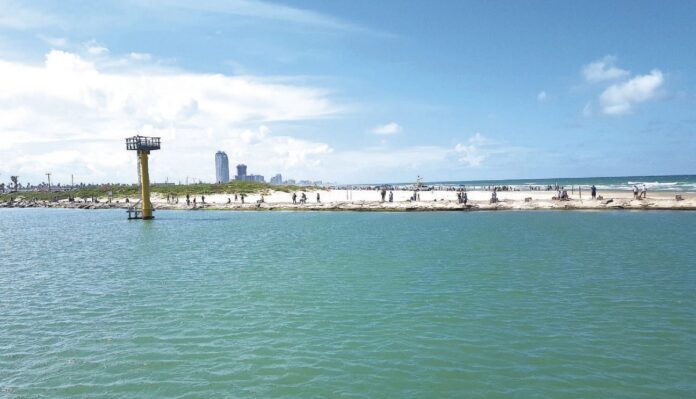SOUTH PADRE ISLAND – You’ve likely heard the recent scary stories.
A Texas man fighting flesh-eating bacteria after swimming in the Gulf of Mexico off of Port Aransas.
Another Texas man having a leg amputated after also contracting a flesh-eating bacteria following a dip off of Galveston Beach.
Vibrio bacteria, which live naturally in certain coastal waters, are believed to be the cause of these health issues. Compromised immune systems, such as being diabetic, also are believed to be a contributing factor.
But families heading to the South Padre Island beaches this weekend and this summer want to know if that bacteria is here.
Although it is impossible to know for sure, the news looks good for the South Padre Island area.
City of South Padre Island shoreline management director Patrick Barrineau said Vibrio vulnificus likes “more brackish” water with “more shellfish.”
Brackish water is a mix of saltwater and freshwater, usually created when rivers flow into the ocean.
Barrineau said that is not the situation on SPI.
He also said the water around South Padre Island is quite clean, especially where the currents come from the south.
“I really don’t think it’s a problem,” he said. “That happens more in conditions that are not here. There are just a lot of reasons not to worry.”
But, he admitted it is impossible to monitor everything in the water.
For the rest of this story and many other EXTRAS, go to our premium site, www.MyValleyStar.com.
Subscribe to it for only $6.99 per month or purchase a print subscription and receive the online version free, which includes an electronic version of the full newspaper and extra photo galleries, links and other information you can’t find anywhere else.
The main route of exposure to disease-causing organisms in recreational waters is contact with polluted water while swimming, including accidental ingestion of contaminated water.
Swimming in contaminated water most frequently causes gastroenteritis.
Gastroenteritis is the inflammation of the gastrointestinal tract, usually caused by a microorganism.
Symptoms include chills, nausea, diarrhea and fever.
Infections can be the result when pathogenic microorganisms come into contact with small breaks and tears in the skin or ruptures in delicate membranes in the ear or nose resulting from the trauma associated with diving into the water.
According to the Texas State Health Department, there have been 27 reported cases of vibrio infection in the state in 2016.
Approximately 41 percent of those cases involved water contact.
To prevent vibriosis, the CDC recommends the following:
• Avoid eating raw or undercooked oysters or other shellfish. Cook them before eating.
• Always wash your hands with soap and water after handing raw shellfish.
• Stay out of brackish or salt water if you have a wound (including cuts and scrapes), or cover your wound with a waterproof bandage if there’s a possibility it could come into contact with brackish or saltwater, or before touching raw seafood or raw seafood juices.
• Wash wounds and cuts thoroughly with soap and water if they have been exposed to seawater or raw seafood or its juices.
If you develop a skin infection, contact your doctor, especially if your skin has come into contact with brackish or saltwater, raw seafood, or raw seafood juices.
• abdominal cramping • nausea • vomiting • fever • chills
The CDC estimates vibriosis causes 80,000 illnesses and 100 deaths each year in the U.S. Those with compromised immune systems are more at risk to developing vibriosis.




